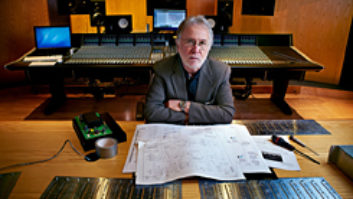There are a lot of tough jobs in the recording industry, but the life of the production mixer is surely the most difficult, most demanding and least appreciated by the general public. While other audio pros often seek to capture and create sounds that seem larger than life, the responsibility of the production mixer is to deliver location dialog tracks — and sometimes effects — that are as clean, flat and unprocessed as possible.
It’s not fair to compare the role of the production mixer to that of the music recording engineer, who stays mainly within the confines of a cushy, air-conditioned environment filled with automated consoles, lavish racks of outboard toys, and leather couches and ergonomically designed chairs at the mix position. Our music engineer friend rolls into work around noon to begin setting up a rock ‘n’ roll session, but the production mixer may have started the day at 3:30 a.m., making a 60-mile drive out to some far-flung location, to be ready to capture every nuance of dialog when the cameras start rolling at dawn.
Production mixers work with gear that’s a little more compact than that of their studio counterparts. The all-important location cart contains all of the essentials, with shelves housing a small (but super-high-fidelity) console, wireless receivers for the radio mics and the recorder — usually DAT, Deva or the venerable Nagra (whether digital or analog). Typically, AC power sources are either nonexistent or too far away to be of any use, so dependable batteries to keep all of this gear at peak performance are the lifeblood of the profession. On location, there are no arguments regarding preferences in main or near-field monitors; a trusted set of headphones is essential, perhaps supplemented by a powered speaker or two for video-assist playbacks.
Weather is always a factor in the life of a production mixer. Besides dusk, darkness or the blazing heat of the Mojave sun, working in rain, dust, sand and dirt can play havoc with gear. Sweat drips into lavalier mics, rendering them useless; high humidity can put a condenser mic out of commission; and in extreme cold, battery life is measured in minutes, rather than hours. An umbrella mount in the corner of the sound cart helps keep sun and rain off of the gear (and sometimes the operator!), but there’s no escaping wind, which not only creates unpleasant conditions for the cast/crew, but makes highpass filters and bulky mic windscreens necessary tools of the trade.
The production recordist must be adept at juggling feeds from multiple wireless units, as well as from fixed and boom-mounted mics, but the overall outcome depends largely on teamwork. An experienced boom operator and cable puller are key players in the quest for clean dialog tracks, and cooperation between the various members of the sound team is vital, particularly in multicamera productions where the director wants to save money by shooting wide-angle and tight shots simultaneously.
No small amount of courage is required when the location sound crew asks for a retake to get a clean dialog track, but going this extra mile makes a huge difference down the line. Every minute of usable location sound saves hours of expensive dialog replacement sessions in post, and here — especially in smaller independent films or television work where budgets are tight — production sound mixers really earn their hero status.
So in this — our fall Sound for Picture issue — we salute the hardest-working group in show business: the production sound mixers.







